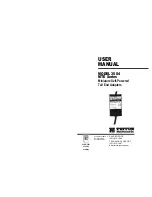
User Manual for the NETGEAR RangeMax™ Wireless USB 2.0 Adapter WPN111
W ire le ss N e tworkin g B a sics
B -3
202-10076-01
802.11b/g Wireless Channels
IEEE 802.11b/g wireless nodes communicate with each other using radio frequency signals in the
ISM (Industrial, Scientific, and Medical) band between 2.4 GHz and 2.5 GHz. Neighboring
channels are 5 MHz apart. However, due to spread spectrum effect of the signals, a node sending
signals using a particular channel will utilize frequency spectrum 12.5 MHz above and below the
center channel frequency. As a result, two separate wireless networks using neighboring channels
(for example, channel 1 and channel 2) in the same general vicinity will interfere with each other.
Applying two channels that allow the maximum channel separation will decrease the amount of
channel cross-talk, and provide a noticeable performance increase over networks with minimal
channel separation.
The radio frequency channels used in 802.11b/g networks are listed in
Table B-1
:
Table B-1:
802.11b/g Radio Frequency Channels
Channel
Center Frequency
Frequency Spread
1
2 4 1 2 M H z
2 3 9 9 . 5 M H z - 2 4 2 4 . 5 M H z
2
2 4 1 7 M H z
2 4 04 . 5 M H z - 2 4 2 9 . 5 M H z
3
2 4 2 2 M H z
2 4 09 . 5 M H z - 2 4 3 4 . 5 M H z
4
2 4 2 7 M H z
2 4 1 4 . 5 M H z - 2 4 3 9 . 5 M H z
5
2 4 3 2 M H z
2 4 1 9 . 5 M H z - 2 4 4 4 . 5 M H z
6
2 4 3 7 M H z
2 4 2 4 . 5 M H z - 2 4 4 9 . 5 M H z
7
2 4 4 2 M H z
2 4 2 9 . 5 M H z - 2 4 5 4 . 5 M H z
8
2 4 4 7 M H z
2 4 3 4 . 5 M H z - 2 4 5 9 . 5 M H z
9
2 4 5 2 M H z
2 4 3 9 . 5 M H z - 2 4 6 4 . 5 M H z
1 0
2 4 5 7 M H z
2 4 4 4 . 5 M H z - 2 4 6 9 . 5 M H z
1 1
2 4 6 2 M H z
2 4 4 9 . 5 M H z - 2 4 7 4 . 5 M H z
1 2
2 4 6 7 M H z
2 4 5 4 . 5 M H z - 2 4 7 9 . 5 M H z
1 3
2 4 7 2 M H z
2 4 5 9 . 5 M H z - 2 4 8 4 . 5 M H z
















































